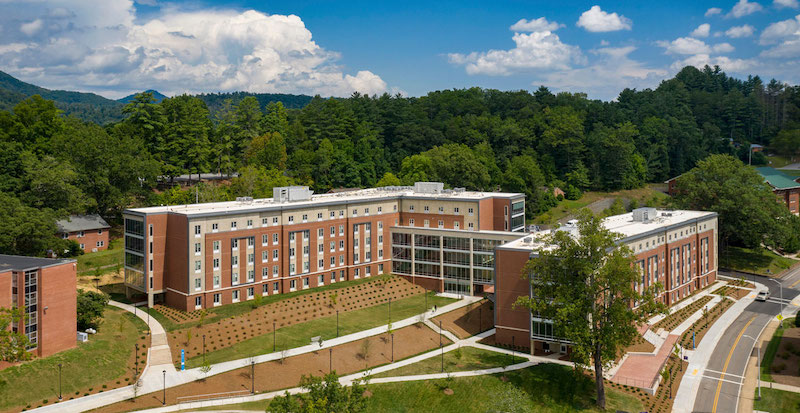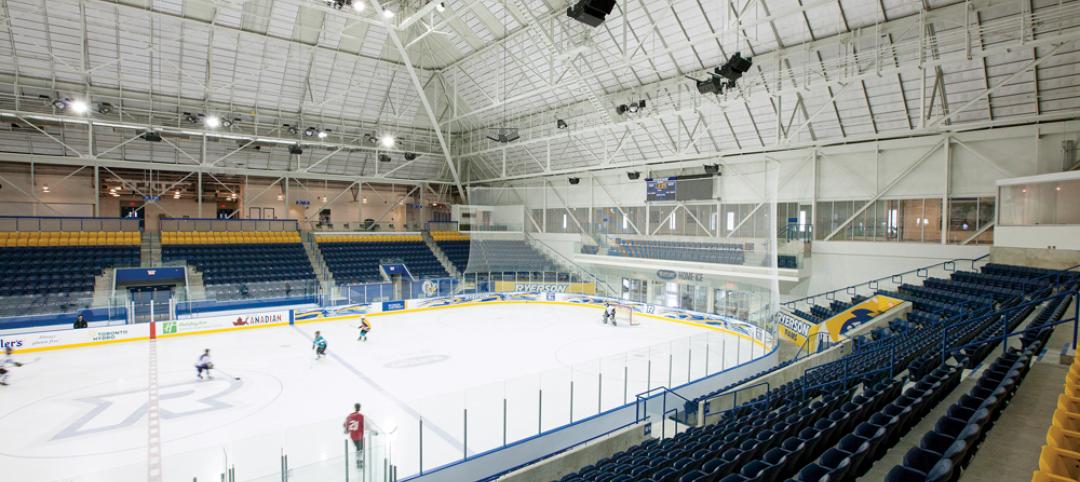When it comes to designing and building new student housing, speed is typically of the essence as colleges and universities are eager to get those beds online as quickly as possible. For schools in regions with inclement winter weather, speed takes on additional meaning: getting dried in before cold temperatures and bad weather arrives ensures construction can keep moving forward despite outdoor conditions.
A variety of material solutions are emerging to accelerate construction timelines, and precast concrete has become an attractive option. The stacking nature of living units make precast and student housing uniquely well-suited to each other. Alongside the need for speed is the importance of ensuring an engaging student life experience, which is critical for student success and retention. The most effective student housing design works with these systems to create the open, inviting social spaces that are fundamental to fostering connections between students.
Capitalizing on Speed, Cost, and Other Side Benefits
Precast concrete systems offer a number of advantages: the building(s) go up faster, the overall project cost is often lower, and side benefits like inherent fire rating, sound proofing, and insulation add extra appeal. No system is perfect – concrete is rigid, gets poor marks for embodied carbon, and has limitations in terms of spans and floor-to-floor height – but the product offers an undeniable value in the multi-unit housing world.
At Western Carolina University, using precast concrete for the new Allen Hall’s exterior walls, floor slabs, and roof reduced the typical construction timeline by six months. Not only did the project get under cover more quickly, the product essentially saved a year in university time by allowing the new facility to open in fall 2019 rather than fall 2020.
Similar to WCU, when Clemson’s Douthit Hills Student Community was designed and built, speed of construction was the predominant factor in the selection of precast concrete. At the time, Metromont was the only manufacturer with this type of innovative system, but today, other manufacturers have entered the market and are creating a more competitive cost landscape.
 The Douthit Hills Student Community is the largest capital project in Clemson’s history, encompassing seven new residence halls and a central Hub building. It delivered on a key goal to make on-campus housing more attractive to students, achieving full occupancy within two days of opening for lease.
The Douthit Hills Student Community is the largest capital project in Clemson’s history, encompassing seven new residence halls and a central Hub building. It delivered on a key goal to make on-campus housing more attractive to students, achieving full occupancy within two days of opening for lease.
Beyond shortening the construction schedule, precast concrete offers a variety of other perks. It reduces the demand for on-site labor (and for construction during COVID, allows for more space between workers). For campuses struggling with budgets, it is an increasingly appealing option. While the systems are expensive, the overall project realizes cost savings driven by things you don’t have to do and the naturally long lifecycle of concrete, which produces 50- to 100-year buildings versus 25-year buildings.
The “things you don’t have to do” include a host of items. The smooth underside of the slab means you can leave it exposed, paint it, and call it a day – skipping the labor and material costs associated with drywall, which can save hundreds of thousands of dollars. The same is true in circumstances where corridors have smooth walls that can be left exposed and painted. Concrete inherently gives the design its fire rating – an advantage on housing projects. It also delivers sound proofing and insulation thanks to its dense structure. In addition to a long building lifecycle, concrete reduces annual maintenance as a result of its durability. Students are typically hard on their residence halls, and concrete stands up to that wear and tear much better than drywall.
Alongside getting dried in before winter weather, the longevity of a concrete building was a factor in its selection by Virginia Tech, which is using a precast system for the first time on its newest addition to the Upper Quad. In contrast to both Clemson and WCU, which left up to 40% of the precast concrete exposed on the exterior façade, VT will integrate its iconic Hokie Stone.
 The new Upper Quad Residence Hall will house nearly 300 cadets once complete. The design team was able to open up space within the building and accommodate more beds by taking advantage of space created at the attic between the concrete slab and the pitched roof to house the building’s mechanical equipment.
The new Upper Quad Residence Hall will house nearly 300 cadets once complete. The design team was able to open up space within the building and accommodate more beds by taking advantage of space created at the attic between the concrete slab and the pitched roof to house the building’s mechanical equipment.
The different approaches taken by Clemson, WCU, and VT showcase the aesthetic opportunities offered by the precast product. For example, the exterior brick on WCU’s Levern Hamlin Allen Hall (with the exception of the first floor) is a thin veneer that is integral to the concrete panel, reducing on-site labor and making construction more efficient.
 Architecturally, visual interest is added to the exterior façade by using a form liner on the precast concrete and integrating a metal brow and shadow boxes for depth.
Architecturally, visual interest is added to the exterior façade by using a form liner on the precast concrete and integrating a metal brow and shadow boxes for depth.
Ensuring A Good Student Experience Through Design
The success of any student housing project can ultimately be measured by how students make use of the spaces and engage with each other. While speed of construction is the primary reason for selecting precast concrete for student housing, our architects work with manufacturers and contractors to integrate the open, airy lobbies and common spaces that appeal to students. David Goldsmith, AIA, an architect in our Asheville office, notes that it was “very important to ensure the design had those high quality, high profile social spaces. When you’re working within a system like this, open environments can be achieved but it requires collaboration and extra effort between the design team and the precast manufacturer.”
At WCU, this collaboration led to the creation of two-story atriums at each of the three primary entry points. Our structural engineer, Marcus Whitaker, PE, shares that working with Metromont’s engineers made these results possible. “Their knowledge of the product was critical; together, we found ways to use the deck product to eliminate beams and columns, which in turn enabled the design to have large, light-filled social spaces.” Both David and Marcus expressed that the shared, intentional effort to provide a variety of inviting commons areas was central to the project’s success.
 Storefront glazing along the pedestrian bridge and group study rooms that cap each residential corridor allow more natural light into the building and reinforce students’ sense of connection with the campus beyond. The design team capitalized on the use of precast in these bright open spaces. By using a form liner pattern and exposing the concrete on the interior, it stands out as a reveal and complements the clean, white walls and sleek wood paneling. Photos courtesy Vannoy Construction.
Storefront glazing along the pedestrian bridge and group study rooms that cap each residential corridor allow more natural light into the building and reinforce students’ sense of connection with the campus beyond. The design team capitalized on the use of precast in these bright open spaces. By using a form liner pattern and exposing the concrete on the interior, it stands out as a reveal and complements the clean, white walls and sleek wood paneling. Photos courtesy Vannoy Construction.
Throughout the building, the precast concrete deck achieved long, 30 foot spans with a low floor-to-floor height, thanks to being filled in part with foam. This composition resulted in a vertically shorter, more efficient building while allowing higher ceilings (9 ½ to 10 feet, versus 8 feet) in the interior spaces. Precast concrete can also be precut to accommodate conduit, concealing the building systems for a smoother aesthetic. All drawings – architectural, mechanical, and electrical – must be well-coordinated and precise to ensure this effort is executed well in the field.
Precast concrete systems like those used by Clemson, VT, and WCU offer compelling benefits for student housing. The growth of this market with multiple companies now offering similar precast systems is meeting demand while increasing competition on cost. As we continue to see schools (and developers on P3 projects) prioritize speed of delivery and construction cost savings on student housing projects, I expect we’ll also see these systems used more frequently.
Related Stories
| Nov 15, 2013
Metal makes its mark on interior spaces
Beyond its long-standing role as a preferred material for a building’s structure and roof, metal is making its mark on interior spaces as well.
| Nov 13, 2013
Installed capacity of geothermal heat pumps to grow by 150% by 2020, says study
The worldwide installed capacity of GHP systems will reach 127.4 gigawatts-thermal over the next seven years, growth of nearly 150%, according to a recent report from Navigant Research.
| Oct 30, 2013
15 stellar historic preservation, adaptive reuse, and renovation projects
The winners of the 2013 Reconstruction Awards showcase the best work of distinguished Building Teams, encompassing historic preservation, adaptive reuse, and renovations and additions.
| Oct 30, 2013
11 hot BIM/VDC topics for 2013
If you like to geek out on building information modeling and virtual design and construction, you should enjoy this overview of the top BIM/VDC topics.
| Oct 18, 2013
Researchers discover tension-fusing properties of metal
When a group of MIT researchers recently discovered that stress can cause metal alloy to fuse rather than break apart, they assumed it must be a mistake. It wasn't. The surprising finding could lead to self-healing materials that repair early damage before it has a chance to spread.
| Oct 8, 2013
Toronto Maple Leafs arena converted to university recreation facility
Using steel reinforcement and massive box trusses, a Building Team methodically inserts four new floors in the landmark arena while preserving and restoring its historic exterior.
| Oct 7, 2013
10 award-winning metal building projects
The FDNY Fireboat Firehouse in New York and the Cirrus Logic Building in Austin, Texas, are among nine projects named winners of the 2013 Chairman’s Award by the Metal Construction Association for outstanding design and construction.
| Oct 1, 2013
13 structural steel buildings that dazzle
The Barclays Center arena in Brooklyn and the NASCAR Hall of Fame in Charlotte, N.C., are among projects named 2013 IDEAS2 winners by the American Institute of Steel Construction.
| Sep 24, 2013
8 grand green roofs (and walls)
A dramatic interior green wall at Drexel University and a massive, 4.4-acre vegetated roof at the Kauffman Performing Arts Center in Kansas City are among the projects honored in the 2013 Green Roof and Wall Awards of Excellence.
| Sep 19, 2013
What we can learn from the world’s greenest buildings
Renowned green building author, Jerry Yudelson, offers five valuable lessons for designers, contractors, and building owners, based on a study of 55 high-performance projects from around the world.

















